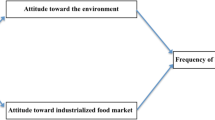Abstract
This paper reports research on consumer preferences for factors associated with the purchase of premium and specialty food items in an upper level market environment. A series of focus groups and a survey was conducted to determine the importance of various factors that influence the decision to patronize a retail location of this type.
Access this chapter
Tax calculation will be finalised at checkout
Purchases are for personal use only
Similar content being viewed by others
References
Calder, Bobby J. (1977), “Focus Groups and the Nature of Qualitative Marketing Research,” Journal of Marketing Research, (August), 353–369.
Darden, William R., and James R. Lumpkin (1984), “Psychographic and Demographic Profiles of Convenience Store Users: Why People Convenience Shop,” Review of Business and Economic Research, 19 (Spring), 68–80.
Doti, James L. and Samuel Sharrir (1981), “Households0 Evidence,” Economic Inquiry, 19, 196–208.
Hawes, Jon M. and G. E. Riser (1980), “Using Generics to Identify the Generic Brand -Prone Grocery Shopper,” Akron Businessand Economic Review, 11, 7–12.
Haynes, Joel B. and Clifford J. Elliot (1980), “Supermarket Selection Criteria: A Comparison of Managers and Customers,” Baylor Business Studies, 11, 65–71.
Johnson, Scott Lee, Sommer, Robert, and Victor Martino (1985), “Consumer Behavior at Bulk Food Bins,” Journal of Consumer Research, 12 (June) 114–117.
Keng, Kau Ah and Ehrenberg, A.S.C. (1984), “Patterns of Store Choice,” Journal of Marketing Research, 21 (November) 399–409.
Muller, Thomas E. (1984), “Buyer Response to Variations in Product Information Load,” Journal of Applied Psychology, 69, 300–306.
Zeithaml, Valerie A. (1982), “Consumer Response to In-Store Price Information Environments,” Journal of Consumer Research, 8,357–369.
Author information
Authors and Affiliations
Editor information
Editors and Affiliations
Rights and permissions
Copyright information
© 2015 Academy of Marketing Science
About this paper
Cite this paper
Powers, T.L. (2015). Consumer Product Preferences in Upper Level Supermarket Environments. In: Bahn, K. (eds) Proceedings of the 1988 Academy of Marketing Science (AMS) Annual Conference. Developments in Marketing Science: Proceedings of the Academy of Marketing Science. Springer, Cham. https://doi.org/10.1007/978-3-319-17046-6_121
Download citation
DOI: https://doi.org/10.1007/978-3-319-17046-6_121
Publisher Name: Springer, Cham
Print ISBN: 978-3-319-17045-9
Online ISBN: 978-3-319-17046-6
eBook Packages: Business and EconomicsBusiness and Management (R0)



